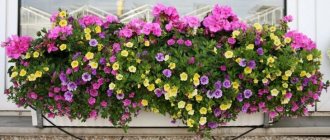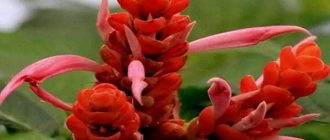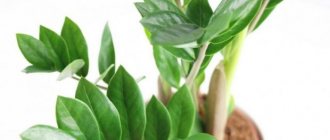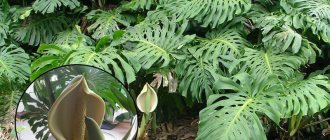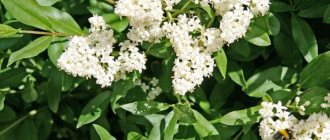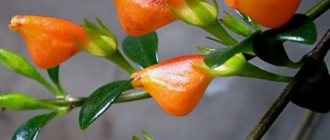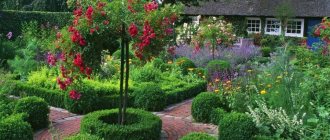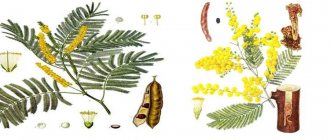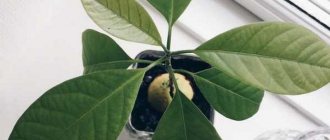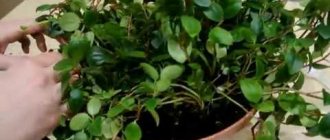Tradescantia is a decorative vine from the Commelinaceae family. The homeland of the evergreen perennial is South America. The wild culture was brought to Europe at the beginning of the 17th century. The court botanist and gardener John Tradescant, together with his son, also named John, traveled the world and collected exotic plants. In the royal parks they studied and bred Tradescantia. The flower is named in their honor.
Features of Tradescantia
All varieties of Tradescantia are not demanding in care and are hardy.
People call an indoor flower with creeping, weaving stems “woman's gossip.”
Lodging vines quickly take root in the soil, releasing roots from the internodes.
Some varieties grow as low bushes with straight branches.
The leaf plates are arranged alternately. The leaf shape, depending on the type, can be elongated-ovate with a sharp tip, elliptical or lanceolate. Plants with small green leaves are more common, but there are also variegated (variegated) varieties.
The flowering period lasts 3-4 months. Inflorescences are formed in the axils of leaf blades or on the tops, the buds open alternately. Small three-petal flowers in green cups are collected in inflorescences. The delicate shades of the petals (from white to lilac) are enlivened by the bright yellow anthers on the long stamens.
The flower blooms for only one day and closes in cloudy weather and at night. The inflorescences attract insects (including bees), although they are odorless.
In place of the pollinated flower, a box with oblong seeds is formed.
Tradescantia indoors - beneficial properties
The plant performs not only a decorative function. Tradescantia is an excellent air purifier. In addition, many pets love to feast on it. The flower plays a huge role in folk medicine: decoctions, tinctures and other homemade remedies from it are used with impressive success to treat many diseases.
Indoor air purification
The plant successfully filters out various volatile organic compounds. In addition, the flower is able to neutralize electromagnetic radiation, cleans the air from dust, tobacco smoke, and harmful fumes of toxic materials. It is recommended to place it in rooms where there are a lot of household appliances and computers. The bush not only cleans, but also moisturizes the air.
Nutrients for pets and fish
Pets simply adore tradescantia and feast on it with pleasure. Cats especially like Tradescantia. They love to pluck leaves that are rich in nutrients. They are also eaten by domestic ornamental birds, hamsters, and guinea pigs. If you place a pot of netcreasia on the edge of your home aquarium, you will provide fish, turtles and other inhabitants with tasty and healthy food.
Brief description of cultivation
Any type of Tradescantia can be grown without any problems. Most do not tolerate cold weather, but varieties have been bred that can overwinter in open ground at a temperature of +5-6°C.
The herbaceous vine grows as a ground cover, but is more often used as an ornamental hanging plant. It gets along well with other cultures.
Tradescantia is grown in greenhouses, winter gardens, office premises and apartments.
Flowerpots suspended on brackets look impressive. Hanging and intertwining, flexible branches decorate a wall or balcony.
If you plant an unhardened indoor plant in a flowerbed, it will quickly lose its attractiveness. The leaves become weathered and thin, and the shoots suffer from insect pests.
Purchase and adaptation
Tradescantia needs adaptation after purchase. This is especially true for exotic varieties. They are transported in special containers with peat substrate - the flower will not live in them for long.
Be sure to check the soil in which the flower grows. If necessary, immediately transplant it into a more suitable substrate.
Quarantine lasts 2-3 weeks. The plant should be placed separately from other crops already in the house. It may harbor pests or be a carrier of infection.
Caring for Tradescantia at home
If the plant is viable, it is still better to follow the basic rules of care and maintain comfortable conditions.
Illumination
The tropical flower prefers diffused light; it is better to place it on the eastern or western side.
The sun's rays in the morning or evening will not cause any harm, but the midday summer sun is dangerous; burns may appear on the leaves.
You should not place the flowerpot on a south-facing window sill; it is better to hang the flowerpot at a distance of 1.5-2 m from the window.
Variegated varieties require more diffused light; in the sun, the leaves become thinner and wither.
Temperature
In spring and summer, the comfortable temperature for the plant is +25-26°C. It is useful to ventilate the room without allowing drafts. You can take the pots out onto a glassed-in balcony or loggia.
For wintering, it is better to provide a temperature of +10-12°C, then the lashes will not stretch. If Tradescantia overwinters in a room, you need to increase daylight hours with the help of lighting.
Watering
With the beginning of the growing season, it is necessary to water the flower regularly, preventing the clod of earth from drying out. The liquid should be poured out of the pan. By the end of the growing season, the frequency of watering is reduced to 1 every 5-7 days.
In winter, during a period of relative rest, it is enough to just slightly moisten the soil. Tap water must be settled or boiled, then cooled to room temperature.
Air humidity
The ancestors of indoor Tradescantia are tropical plants, so spraying with a spray bottle and bathing in the shower are useful in spring and summer. The liana also grows at low humidity levels; it is enough to wash off the dust monthly.
Fertilizer
At the end of March, it is recommended to start feeding the plants with organic or mineral fertilizers. Until September, you can fertilize once every 10-12 days, alternating different types of fertilizers. Variegated species are not fed with organic matter.
Trimming
It is better to form a bush in the spring during transplantation. Remove old branches on which leaves grow only at the tops.
Young shoots are pinched so that lateral shoots develop. This can be done throughout the growing season.
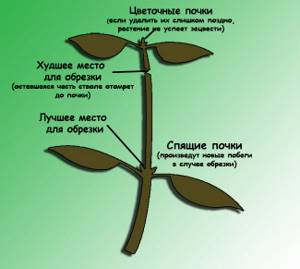
Transplanting Tradescantia
The young plant is replanted annually in the spring. After 3-4 years, it is better to replace Tradescantia.
The soil mixture is prepared from deciduous soil (4 parts), turf (2 parts), leaf humus (2 parts) and coarse river sand (1 part). You should first calcine the soil in the oven for 30-40 minutes.
Broken brick or expanded clay are suitable for drainage.
You need to choose a small but wide pot, since the roots actively grow to the sides. If there is no drainage hole at the bottom of the dish, you will need to make one yourself.
Virulence
Pale Tradescantia is considered a dangerous variety. Its juice causes irritation and hyperemia of the skin. Upon contact with the mucous membrane of the eye, a burning sensation and lacrimation are observed. It is better to wear gloves when replanting or pinching such a bush. After work, you should wash your hands thoroughly with soap or gel.
Reproduction methods
It is recommended to plant Tradescantia in late March-early April.
Growing from seeds
Seedlings are grown in peat pots or disposable cups with a peat-sand mixture. Cover the top with a transparent bag or a cut plastic bottle.
The mini-greenhouse needs to be ventilated regularly, otherwise the soil will become moldy. A seedling grown in this way will reach the flowering stage only after 3 years.
Cuttings
This is the simplest and most reliable way. Stems 10-15 cm long are cut from the old plant and planted in pots of 5-6 pieces. You can get cuttings by cutting a long vine into pieces.
You need to compact and water the soil, then move the flower to the window, shielding it from direct rays. You can stick a film on the glass or cover it with a sheet of paper.
The cuttings will take root in 1.5-2 weeks; side shoots will appear in 2-3 months.
If you put the cut stems in water, they will sprout roots and even grow, you just need to change the water regularly.
Reproduction by division
Sometimes the roots grow, filling the entire container. You need to moisten the lump of earth, carefully divide the rhizome into 2-3 parts (you can cut it with a blade). Then place each part in a separate container with soil and water with lukewarm water.
Possible problems
Tradescantia rarely gets sick. Help will be effective if signs of damage are noticed immediately and adequate measures are taken. Observing the plant every day, you can see the following negative changes:
- the growth of the vine slows down, the shoots become pale and thin;
- the leaves dry out at the edges and turn brown;
- yellowish spots appear on the leaf blades;
- the lashes stretch out, the foliage dries and flies off;
- the leaves of variegated varieties acquire a uniform green color.
The reasons most often are errors in care: insufficient lighting, lack of nutrients and moisture, improper pruning. If rearranging the flowerpot, increased watering or fertilizing does not achieve a positive result, it is better to cut fresh cuttings and grow a new bush.
Diseases and pests
Excessive moisture can lead to rot. First the roots rot, and then the stems. Proper watering and drainage system will help prevent rotting of the root system.
Thrips, spider mites or scale insects can appear on an indoor flower. The main pests of Tradescantia in the garden are slugs and aphids.
With regular inspection, you can notice the pests themselves or signs of damage: leaf blades become dull and deformed, spots appear on them, and shoot growth slows down.
At the first signs of infection, you need to wash the leaves with a solution of laundry soap. If this does not help, insecticides should be used.
Diseases and pests
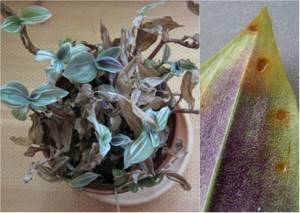
Tradescantia gets sick or suffers from pests no less and no more than any other indoor flower.
The most dangerous disease for Tradescantia is root rot. It occurs due to excessive dampness in the soil. Such a misfortune can only be avoided thanks to the correct watering tactics and the installation of high-quality drainage at the bottom of the container.
Of the pests that can settle on Tradescantia, the following stand out: spider mites (with insufficient watering), aphids, and scale insects.
NOTE! Tradescantia is liked by most domestic cats. They happily gnaw, tear off and spoil the leaves of this plant. Therefore, the flower must be removed away from the pet’s visibility zone.
Types and varieties of Tradescantia with photos and names
The species diversity and hardiness of the plant allowed breeders to develop many varieties with highly decorative qualities.
Anderson's Tradescantia (Tradescantia x andersoniana)
This variety was named after the botanist breeder Edward Anderson. Strengthening the beneficial qualities of Tradescantia virginiana, he developed a whole group of hybrid plants with a variety of flower colors:
- variety "Alba" - with snow-white flowers;
- “Carnea” - with soft pink;
- "Hutchinsonii" - with pale blue;
- "Coccinea" - with purple-red;
- "Caerulea" - with azure blue;
- "Leonora" - with lilac or purple.
The plant is planted in garden plots. A bush with straight stems and lanceolate leaves grows quickly, reaching a height of 50-60 cm. A pair of flowers opens on each stem in the morning. There are many stems, and the bush is strewn with graceful delicate flowers.
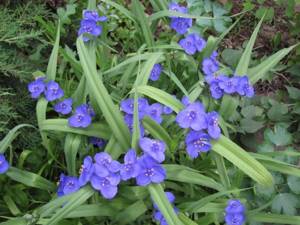
White-flowered Tradescantia (Tradescantia albiflora)
A common crop with large ovoid leaf blades. Blooms rarely; the flowers are small, flat, white. Another name is tricolor.
Varieties differ in leaf color:
- "Tricolor" is decorated with white, pink and lilac stripes;
- "Albovittata" - the leaf is dotted with thin white stripes;
- "Aureovittata" - with golden wide stripes;
- "Aurea" - yellow leaves with green stripes.
The crop can withstand air temperature drops down to +6°C and can survive winter in the southern zone of Russia.

Tradescantia blossfeldiana
A liana with large leaves and succulent creeping stems. The ellipsoidal leaves are green with a red tint on top; the lower part is purple.
The variegated variety is distinguished by its original coloring: creamy-green foliage is shaded with a pinkish bloom. The pattern on adjacent right or adjacent left leaves is repeated, but the patterns of right and left leaves are always different.
On the surface of leaves, twigs and sepals there is pubescence - thin white hairs.
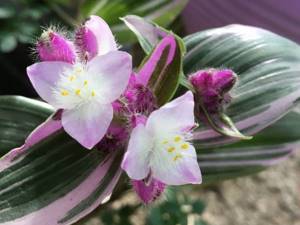
Tradescantia virginiana
The ancestor of many varieties, brought to Europe from the southeast of North America. The stem is low, branched. The leaves are narrow, lanceolate.
Blooms profusely in the summer months. The flowers are large, purple, bright blue or pink. When the flower closes at night, under the influence of enzymes, it turns into a jelly-like transparent drop. That’s why people called it “Widow’s Tears.”
Thanks to its endurance and stability, the perennial retains its decorative qualities both when grown at home and in open ground.
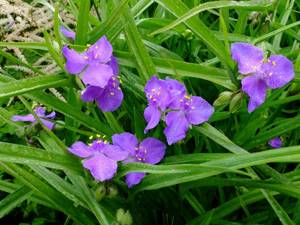
Tradescantia pilosa
This variety is rare. A distinctive feature is thick pubescence, which protects from the bright sun and helps conserve moisture. All parts of the plant are covered with long white hairs. The flowers are pink or pale lilac.
The fluffy protection allows this variety to be grown on the south side of the house.
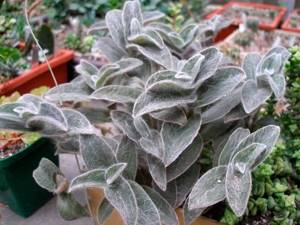
Zebra-shaped Tradescantia (Tradescantia zebrina)
A plant with large leaf blades and a creeping stem. Two wide silver stripes run along the front side of the green-lilac leaf plate.
The lower part of the foliage, stems and twigs have a reddish tint. Small pink or lilac flowers are collected in small inflorescences.
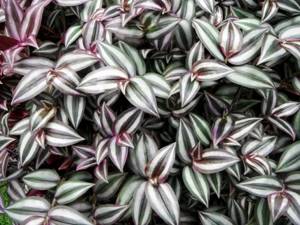
Tradescantia navicularis
This variety of botany was classified as succulents. Thick, medium-sized leaves sit tightly on short, fleshy stems. The leaf shape resembles a boat; There are many lilac dots scattered along the edge and bottom of the plate.
Grows well on clay and sandy soils.
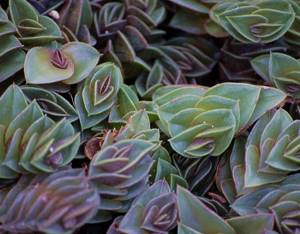
Tradescantia multicolor
A variegated crop with green leaves covered with white and pink longitudinal stripes. Spectacular appearance and easy maintenance are often used when decorating industrial premises.
